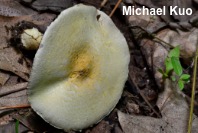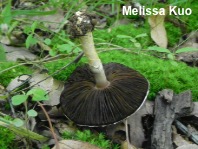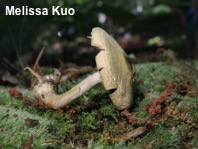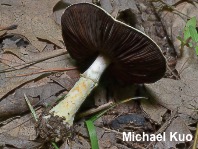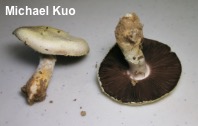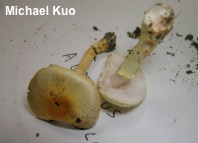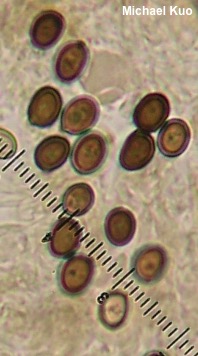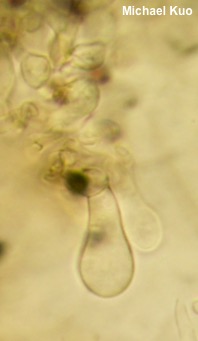| Major Groups > Gilled Mushrooms > Dark-Spored > Agaricus > Agaricus auricolor |

|
Agaricus auricolor [ Basidiomycota > Agaricales > Agaricaceae > Agaricus . . . ] by Michael Kuo I am using "Agaricus auricolor" as a label for a poorly known group of smallish, yellow, woodland Agaricus species from the southeastern states and the southern Midwest, most of which were described in the early 20th Century and have not been examined with contemporary collections and methods. Have you found a relatively small, yellow Agaricus? Please consider helping scientists to examine this group of species by documenting, preserving, and contributing your specimens. Further information and relatively easy instructions can be found here. Described below and illustrated to the right are collections from southern Illinois and Ohio. They may not actually represent Agaricus auricolor (which, according to Krieger in 1927, should have a bell-shaped cap and pointed stem base—and which, by the way, is an illegitimate name by the rules of taxonomy since it had already been used by someone else, for a different mushroom, when Krieger named his species). Other similar, poorly known species include Agaricus citrinidiscus, with a "citrinous" cap, and Agaricus sulphureiceps, with a "sulphureous" cap (both described from Florida by Murrill and featuring enlarged, rather than pointed, stem bases). Coker (1928) treated a very different mushroom—a compost and grass-inhabiting species with the stature of Agaricus campestris and a strong odor of almonds—as Agaricus auricolor; some later authors (Freeman 1979; Smith, Smith & Weber 1979) followed Coker's lead. However, Krieger's original 1927 illustration and description (reproduced in Kerrigan 2016) do not agree with this tradition. Until new collections are documented and studied, there is little hope of sorting out whether or not these species can actually be separated using the features that century-old descriptions emphasize. Description: Ecology: Saprobic; growing alone or scattered in hardwood forests; summer; southern Illinois and Ohio; possibly distributed throughout southeastern North America (see discussion above). The illustrated and described collections are from Illinois and Ohio. Cap: 2.5–6 cm; convex to bell-shaped at first, becoming broadly convex or nearly flat; dry; radially fibrillose and scaly with orangish yellow to yellow scales over a pale yellow surface; the margin not lined, sometimes featuring whitish veil remnants when young, yellowing when rubbed repeatedly. Gills: Free from the stem; close or crowded; short-gills frequent; white when young, becoming dark brown with maturity; covered with a pale yellow partial veil when in the button stage. Stem: 3–5 cm long; 3–6 mm thick; equal above a slightly swollen base; fibrillose to shaggy; with a thin, collapsing, pale yellow ring; whitish above the ring, yellowish below; yellowing when rubbed; basal mycelium white. Flesh: White; unchanging when sliced. Odor and Taste: Not distinctive. Chemical Reactions: KOH yellow on cap surface and stem base. Spore Print: Dark brown. Microscopic Features: Spores: 4–5 x 3–4 µm; ellipsoid; smooth; thick-walled; brown in KOH; brown in Melzer's. Basidia 4-sterigmate. Cheilocystidia 10–25 x 6–10 µm; septate; clavate; smooth; thin-walled; hyaline in KOH. Pleurocystidia not found. Pileipellis a cutis. REFERENCES: L. Krieger, 1927 (Coker, 1928; Freeman, 1979; Smith, Smith & Weber, 1979; Kerrigan, 2016). Herb. Kuo 06081301, 06071505. This site contains no information about the edibility or toxicity of mushrooms. |
© MushroomExpert.Com |
|
Cite this page as: Kuo, M. (2018, February). Agaricus auricolor. Retrieved from the MushroomExpert.Com Web site: http://www.mushroomexpert.com/agaricus_auricolor.html |
